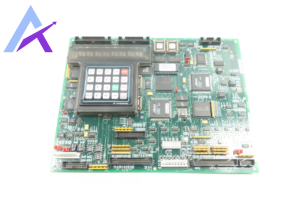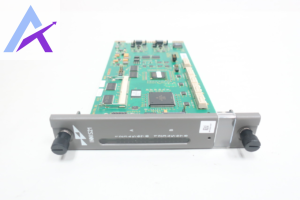GE IC698CPE030-GL
GE IC698CPE030-GL: A Comprehensive Guide to Technical Parameters, Industry Applications, and Related Models
The GE IC698CPE030-GL is a high-performance Central Processing Unit (CPU) from the GE Fanuc RX7i series, engineered to meet the rigorous demands of modern industrial automation. With its advanced technical specifications, including a 600 MHz Intel Pentium-M microprocessor and 64 MB of user memory, this CPU is a vital component for industries requiring real-time control of machines, processes, and material handling systems. In this in-depth article, we explore the technical parameters of the IC698CPE030-GL, its wide-ranging industry applications, and related models with their specifications, offering valuable insights for engineers, system integrators, and automation professionals.
Introduction to the GE IC698CPE030-GL
The GE IC698CPE030-GL stands out as a robust and reliable CPU within the RX7i PAC Systems family. Designed for high-speed data processing and extensive memory capacity, it supports a variety of I/O and communication modules, making it an ideal choice for complex automation tasks. Whether you’re managing power generation systems, oil and gas operations, or manufacturing processes, this industrial automation CPU delivers the performance and flexibility needed to optimize operations.
With features like battery-backed memory, non-volatile flash storage, and support for the VME64 standard, the IC698CPE030-GL ensures system reliability and scalability. This article provides a detailed look at why this GE Fanuc RX7i series CPU with 600 MHz is a cornerstone of industrial control systems worldwide.
Technical Parameters of the GE IC698CPE030-GL
The GE IC698CPE030-GL is packed with technical features that make it a standout performer in industrial automation. Below, we break down its key specifications to highlight its capabilities.

Processor and Memory Specifications
- Processor: Intel Pentium-M microprocessor, 600 MHz
- User Memory: 64 MB of battery-packed RAM for storing programs and data
- Flash Memory: 64 MB of non-volatile flash memory for firmware and user data
- Memory Access: Bulk memory access for efficient data management
- Configurable Memory: Flexible allocation of program and data memory
- Symbolic Variables: Auto-located symbolic variables for streamlined programming
The Pentium-M microprocessor provides the computational power necessary for real-time process control, while the 64 MB of user memory and flash storage ensures ample space for large programs and datasets. This combination is particularly beneficial for applications requiring high-speed data processing and long-term data retention, such as in industrial control systems with VME64 standard.
Communication Ports and Interfaces
- Serial Ports: Three isolated serial ports
- RS-485 serial port
- RS-232 serial port
- RS-232 Ethernet station manager port
- Ethernet Port: Built-in Ethernet port for high-speed communication
- Backplane Communication: VME64 standard for interfacing with I/O and option modules
The variety of communication options enhances the IC698CPE030-GL’s ability to integrate into diverse industrial networks. The Ethernet port facilitates fast data exchange with programmers and Human-Machine Interfaces (HMIs), while the VME64 backplane ensures compatibility with a wide range of modules, making it a versatile RX7i CPU.
Additional Features
- Self-Diagnostic Check: Comprehensive diagnostics on power-up
- LED Indicators: Status LEDs for monitoring CPU operation
- Battery Backup: Lithium battery pack (IC698ACC701) for memory retention and clock operation
- Module Support: Compatible with Series 90-70 I/O, communication, and VME modules
These features improve the CPU’s reliability and ease of use. For instance, the self-diagnostic routine helps detect issues early, reducing downtime—a critical advantage in mission-critical applications.
Industry Applications of the GE IC698CPE030-GL
The GE IC698CPE030-GL excels in a variety of industrial settings due to its processing power and robust design. Here’s how it’s applied across key industries:
Power Generation
In power generation, the IC698CPE030-GL controls turbines, generators, and auxiliary systems. Its ability to process complex algorithms and handle large datasets ensures efficient operation and precise monitoring of critical parameters like temperature and voltage. This makes it an essential component in real-time process control for power plants.
Oil and Gas
The oil and gas sector uses the IC698CPE030-GL for drilling operations, pipeline monitoring, and refinery automation. Its rugged design and support for multiple communication protocols make it ideal for harsh environments, ensuring continuous and safe operation in industrial automation CPU applications.
Manufacturing and Process Control
In manufacturing, this CPU automates production lines, robotic systems, and material handling processes. Its real-time data processing capabilities improve product quality and efficiency, while its compatibility with various I/O modules offers flexibility for diverse manufacturing needs.
Related Models and Their Parameters
The GE IC698CPE030-GL is part of the RX7i series, which includes other CPUs and modules designed for seamless integration. Below, we compare related models and their specifications.
Other RX7i CPUs
- IC698CPE020: 300 MHz CPU, 10 MB user memory, 10 MB flash memory. A cost-effective option for smaller systems.
- IC698CPE040: 1.8 GHz CPU, 64 MB user memory, 64 MB flash memory. Offers higher performance for complex applications.
The IC698CPE020 suits less demanding tasks, while the IC698CPE040 is ideal for high-speed, data-intensive operations compared to the IC698CPE030-GL.
Compatible I/O Modules
- IC697MDL250: 32-point discrete input module, 120 VAC, for monitoring discrete signals.
- IC697ALG320: 16-channel analog output module, supporting voltage/current outputs for analog control.
These modules, available at AECNC Parts, enhance the CPU’s adaptability to specific application needs.
Communication Modules
- IC698ETM001: Ethernet interface module for network expansion.
- IC698CMX016: Control Memory Xchange module for high-speed data sharing between CPUs.
These modules improve connectivity and scalability in distributed control systems.
Power Supply Options
- IC698PSA350: 350-watt power supply for large systems.
- IC698PSD300: 300-watt power supply for smaller setups.
Choosing the right power supply ensures system stability and performance.
Installation and Configuration
Mounting and Hardware Setup
The IC698CPE030-GL mounts in an RX7i rack, connecting via the VME64 backplane. Ensure secure installation and adequate power supply compatibility.
Software Configuration
Program the CPU using GE’s Proficy Machine Edition, supporting ladder logic and structured text. Configure memory and communication settings for optimal performance.
Maintenance and Troubleshooting
Routine Maintenance
- Replace the IC698ACC701 battery periodically.
- Update firmware via AECNC Parts.
Common Issues
- Communication Errors: Check cables and settings.
- Memory Issues: Verify battery and memory allocation.
Refer to the IC698CPE030 manual for detailed guidance.

Conclusion
The GE IC698CPE030-GL is a powerful RX7i CPU that excels in industrial automation. Its technical prowess and versatility make it a top choice for power generation, oil and gas, and manufacturing. Explore related models and components at AECNC Parts to build your ideal system.



